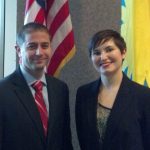
The Smithsonian Institution Mentorship Program is an annual 9-month program dedicated to “developing leaders throughout the Institution” through professional development in the areas of networking, interpersonal skills, coaching, and institutional engagement. This past year, 60 participants, consisting of 30 mentors and 30 “mentees,” were selected as a result of a competitive application process. In addition to a curriculum of monthly training courses, the program provided rare opportunities for behind-the-scenes tours and meetings with notable leaders across the Institution including Secretary Clough. Mentees worked with their mentors to achieve a set of personal goals through a variety of learning opportunities, thus each experience of the program was unique. Smithsonian Libraries was proud to have 2 mentees in the 2012 Mentorship program, Bianca Crowley and Dave Opkins. Below, each will describe their experiences working with their mentors and their key takeaways.






